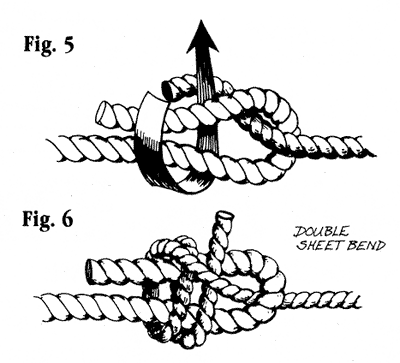The Rope Locker
Sheet Bend
By David Seidman
Small Boat Journal #50 September 1986
A bend is a knot used to join two
ends of line. And like love at first sight, our first instincts
about the bend usually lead to disaster.
Given two lines to join, the uninitiated
thinks of his shoe laces and ties a square knot. This knot is
fine for a few very specific uses; but its tendency to come apart
easily or break under strain will almost certainly
result in havoc or tragedy. There have probably been more lives
lost from using a square knot as a bend than from any other knot.
Keep square knots on your shoes and reef points, and away from
everything else.
lf you have to remember only one
bend, the easiest to tie, the strongest, and the most versatile
is the sheet bend. Named for its use in attaching sheets to the
clews of square sails (clews on old sails were in the form of
eyesplices or "beckets," so the original name of the
knot was the becket hitch), this bend has proven itself over the
centuries as the all-purpose bend.
Method A (fast)
-
Notice the similarity between
a bowline
and a sheet bend. The bowline uses the sheet bend to form
a loop by joining an end of line somewhere on the standing
part of that line. lfyou can tie one, you've got both.
-
With your palm down, hold
the end of one line between your fore and index fingers. Place
your fingers over the standing part of the second line and
grasp it with your thumb (Fig.1). Now twist your wrist so
your palm faces up. This forms a bight in the second line
called a "Cuckhold's Neck" (Fig. 2).

-
Pass the end of the
first line around as shown (Fig. 3). Remember: when the end
passes over one part, it must then pass under the next. Always
alternate.
-
Once the knot is formed,
snug it up before putting it into service.
-
To untie, push the
loop back and forth to loosen it (Fig. 4).
Method B (for heavy lines)
This method is best for less flexible
or heavier lines. Tying it this way also gives you a better insight
into the internal workings of the knot.
Form a loop in one line and reeve
the second line through and around it (Fig 5).

The double sheet bend gives extra
security from slipping by taking turns of the second line around
the loop (Fig. 6). The second line enters the loop from underneath,
not from above, as in the First drawing. A proper knot can be
formed this way as long as the second line exits the loop
on the loop's short ended side.
Method C (tricky)
This only works with light line.
In one line, create a noose with
an overhand knot. Stick the end of the second line through the
noose.
Pull the standing and working ends
of the noose apart (Fig. 7). The noose will swallow the second
line and create a sheet bend. It's a little awkward at first,
but you'll get it after a few tries. Not really practical, but
fun.

Remember! All bends should be considered
temporary. For permanence, use splices.
David Seidman
|

